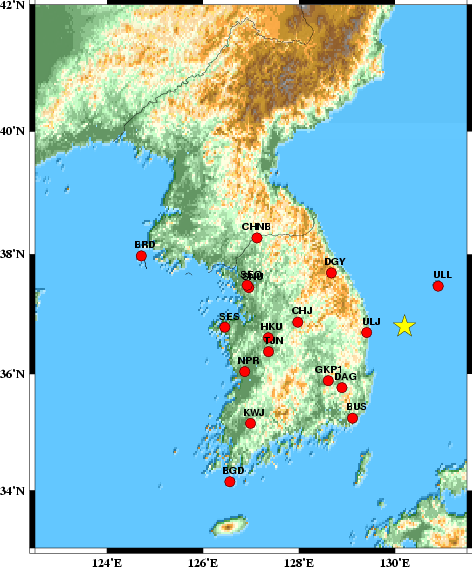
2004/05/29 10:14:24 36.67N 129.94E 11 5.08 Korea
SLU Moment Tensor Solution
2004/05/29 10:14:24 36.67N 129.94E 11 5.08 Korea
Best Fitting Double Couple
Mo = 4.68e+23 dyne-cm
Mw = 5.08
Z = 11 km
Plane Strike Dip Rake
NP1 193 62 101
NP2 350 30 70
Principal Axes:
Axis Value Plunge Azimuth
T 4.68e+23 71 127
N 0.00e+00 10 7
P -4.68e+23 16 275
Moment Tensor: (dyne-cm)
Component Value
Mxx 1.59e+22
Mxy 1.01e+22
Mxz -9.83e+22
Myy -3.97e+23
Myz 2.40e+23
Mzz 3.81e+23
--------##----
------------####------
--------------#######-------
-------------###########------
--------------#############-------
--------------################------
--------------##################------
--------------###################-------
--------------####################------
-- ---------#####################-------
-- P ---------######################------
-- ---------######### ##########------
-------------########## T ##########------
------------########## ##########-----
------------######################------
-----------######################-----
----------#####################-----
---------####################-----
--------##################----
-------#################----
-----##############---
--##########--
Harvard Convention
Moment Tensor:
R T F
3.81e+23 -9.83e+22 -2.40e+23
-9.83e+22 1.59e+22 -1.01e+22
-2.40e+23 -1.01e+22 -3.97e+23
|
USGS Fast Moment Tensor Solution
04/05/29 10:14:26.70
SOUTH KOREA
Epicenter: 36.670 129.944
MW 5.3
USGS MOMENT TENSOR SOLUTION
Depth 17 No. of sta: 5
Moment Tensor; Scale 10**17 Nm
Mrr= 0.65 Mtt= 0.32
Mff=-0.97 Mrt=-0.54
Mrf= 0.02 Mtf= 0.20
Principal axes:
T Val= 1.05 Plg=53 Azm=175
N -0.04 37 347
P -1.01 4 80
Best Double Couple:Mo=1.0*10**17
NP1:Strike=202 Dip=52 Slip= 139
NP2: 320 59 46
#######
#############----
############---------
--------###--------------
------------#----------------
-----------#####---------------
----------########------------
----------###########---------- P
----------############---------
---------###############---------
--------#################--------
--------##################-------
-------######## #######------
-------######## T ########-----
------######## ########----
----###################--
---##################
--###############
#######
|
Harvard CMT
052904B SOUTH KOREA
Date: 2004/ 5/29 Centroid Time: 10:14:30.0 GMT
Lat= 36.71 Lon= 129.93
Depth= 12.0 Half duration= 0.8
Centroid time minus hypocenter time: 4.0
Moment Tensor: Expo=23 4.500 0.110 -4.610 -0.560 1.440 0.410
Mw = 5.1 mb = 5.3 Ms = 5.3 Scalar Moment = 4.83e+23
Fault plane: strike=180 dip=36 slip=99
Fault plane: strike=350 dip=54 slip=84
|
The focal mechanism was determined using broadband seismic waveforms. The location of the event and the station distribution are given in Figure 1.

|
|
|
STK = 350
DIP = 30
RAKE = 70
MW = 5.08
HS = 11
The waveform inversion is preferred. This solution agrees with the surfac-ewave solution. This solution is well determined.
The program wvfgrd96 was used with good traces observed at short distance to determine the focal mechanism, depth and seismic moment. This technique requires a high quality signal and well determined velocity model for the Green functions. To the extent that these are the quality data, this type of mechanism should be preferred over the radiation pattern technique which requires the separate step of defining the pressure and tension quadrants and the correct strike.
The observed and predicted traces are filtered using the following gsac commands:
hp c 0.02 3 lp c 0.10 3The results of this grid search from 0.5 to 19 km depth are as follow:
DEPTH STK DIP RAKE MW FIT
WVFGRD96 0.5 185 60 -90 4.91 0.4884
WVFGRD96 1.0 185 55 -85 4.93 0.4869
WVFGRD96 2.0 185 65 -85 5.00 0.4220
WVFGRD96 3.0 300 20 15 5.00 0.4414
WVFGRD96 4.0 300 20 20 5.00 0.4938
WVFGRD96 5.0 305 20 25 4.99 0.5356
WVFGRD96 6.0 315 20 40 5.00 0.5696
WVFGRD96 7.0 355 20 75 5.02 0.5960
WVFGRD96 8.0 355 20 75 5.03 0.6176
WVFGRD96 9.0 355 25 75 5.05 0.6329
WVFGRD96 10.0 350 25 70 5.06 0.6411
WVFGRD96 11.0 350 30 70 5.08 0.6438
WVFGRD96 12.0 350 30 70 5.09 0.6435
WVFGRD96 13.0 355 35 80 5.09 0.6399
WVFGRD96 14.0 355 40 80 5.10 0.6338
WVFGRD96 15.0 355 40 80 5.11 0.6263
WVFGRD96 16.0 360 45 85 5.11 0.6129
WVFGRD96 17.0 360 45 85 5.13 0.6022
WVFGRD96 18.0 355 45 80 5.13 0.5862
WVFGRD96 19.0 180 40 90 5.13 0.5688
WVFGRD96 20.0 360 50 90 5.14 0.5479
WVFGRD96 21.0 180 40 90 5.14 0.5246
WVFGRD96 22.0 180 35 85 5.15 0.4995
WVFGRD96 23.0 180 35 85 5.15 0.4737
WVFGRD96 24.0 180 35 85 5.15 0.4467
WVFGRD96 25.0 180 35 85 5.16 0.4185
The best solution is
WVFGRD96 11.0 350 30 70 5.08 0.6438
The mechanism correspond to the best fit is

|
|
|
The best fit as a function of depth is given in the following figure:

|
|
|
The comparison of the observed and predicted waveforms is given in the next figure. The red traces are the observed and the blue are the predicted. Each observed-predicted componnet is plotted to the same scale and peak amplitudes are indicated by the numbers to the left of each trace. The number in black at the rightr of each predicted traces it the time shift required for maximum correlation between the observed and predicted traces. This time shift is required because the synthetics are not computed at exactly the same distance as the observed and because the velocity model used in the predictions may not be perfect. A positive time shift indicates that the prediction is too fast and should be delayed to match the observed trace (shift to the right in this figure). A negative value indicates that the prediction is too slow. The bandpass filter used in the processing and for the display was
hp c 0.02 3 lp c 0.10 3

|
|
|

|
| Focal mechanism sensitivity at the preferred depth. The red color indicates a very good fit to thewavefroms. Each solution is plotted as a vector at a given value of strike and dip with the angle of the vector representing the rake angle, measured, with respect to the upward vertical (N) in the figure. |
NODAL PLANES
STK= 185.00
DIP= 50.00
RAKE= 90.00
OR
STK= 5.00
DIP= 40.00
RAKE= 90.00
DEPTH = 11.0 km
Mw = 5.10
Best Fit 0.8222 - P-T axis plot gives solutions with FIT greater than FIT90
 |
The P-wave first motion data for focal mechanism studies are as follow:
Sta Az(deg) Dist(km) First motion ULJ 261 72 iP_D ULL 40 97 iP_D DAG 226 164 iP_C DGY 307 168 iP_C GKP1 235 175 iP_C BUS 210 198 iP_C CHJ 273 199 iP_C HKU 266 255 iP_C TJN 260 258 iP_C SNU 285 297 eP_+ SEO 286 301 eP_+ NPR 255 310 iP_C CHNB 302 317 iP_C SES 271 334 iP_C KWJ 239 342 iP_C BGD 229 442 eP_+ BRD 286 510 eP_+
Surface wave analysis was performed using codes from Computer Programs in Seismology, specifically the multiple filter analysis program do_mft and the surface-wave radiation pattern search program srfgrd96.
Digital data were collected, instrument response removed and traces converted
to Z, R an T components. Multiple filter analysis was applied to the Z and T traces to obtain the Rayleigh- and Love-wave spectral amplitudes, respectively.
These were input to the search program which examined all depths between 1 and 25 km
and all possible mechanisms.

|
|
|

|
| Pressure-tension axis trends. Since the surface-wave spectra search does not distinguish between P and T axes and since there is a 180 ambiguity in strike, all possible P and T axes are plotted. First motion data and waveforms will be used to select the preferred mechanism. The purpose of this plot is to provide an idea of the possible range of solutions. The P and T-axes for all mechanisms with goodness of fit greater than 0.9 FITMAX (above) are plotted here. |

|
| Focal mechanism sensitivity at the preferred depth. The red color indicates a very good fit to the Love and Rayleigh wave radiation patterns. Each solution is plotted as a vector at a given value of strike and dip with the angle of the vector representing the rake angle, measured, with respect to the upward vertical (N) in the figure. Because of the symmetry of the spectral amplitude rediation patterns, only strikes from 0-180 degrees are sampled. |
The distribution of broadband stations with azimuth and distance is
Sta Az(deg) Dist(km) ULJ 262 72 ULL 40 97 DAG 226 164 DGY 307 168 GKP1 235 175 BUS 210 198 CHJ 273 199 HKU 266 255 TJN 260 258 SNU 285 297 SEO 286 301 NPR 255 310 CHNB 302 317 SES 271 334 KWJ 239 342 BGD 230 442 BRD 287 503
Since the analysis of the surface-wave radiation patterns uses only spectral amplitudes and because the surfave-wave radiation patterns have a 180 degree symmetry, each surface-wave solution consists of four possible focal mechanisms corresponding to the interchange of the P- and T-axes and a roation of the mechanism by 180 degrees. To select one mechanism, P-wave first motion can be used. This was not possible in this case because all the P-wave first motions were emergent ( a feature of the P-wave wave takeoff angle, the station location and the mechanism). The other way to select among the mechanisms is to compute forward synthetics and compare the observed and predicted waveforms.
The fits to the waveforms with the given mechanism are show below:
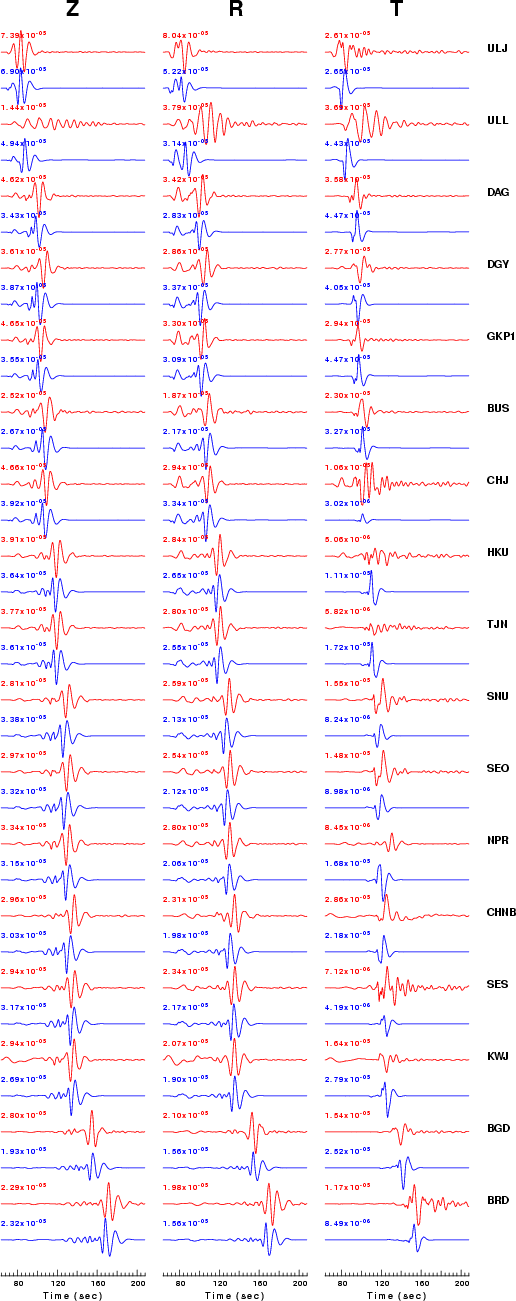
|
This figure shows the fit to the three components of motion (Z - vertical, R-radial and T - transverse). For each station and component, the observed traces is shown in red and the model predicted trace in blue. The traces represent filtered ground velocity in units of meters/sec (the peak value is printed adjacent to each trace; each pair of traces to plotted to the same scale to emphasize the difference in levels). Both synthetic and observed traces have been filtered using the SAC commands:
hp c 0.02 3 lp c 0.10 3

|

|
The figures below show the observed spectral amplitudes (units of cm-sec) at each station and the
theoretical predictions as a function of period for the mechanism given above. The modified Utah model earth model
was used to define the Green's functions. For each station, the Love and Rayleigh wave spectrail amplitudes are plotted with the same scaling so that one can get a sense fo the effects of the effects of the focal mechanism and depth on the excitation of each.
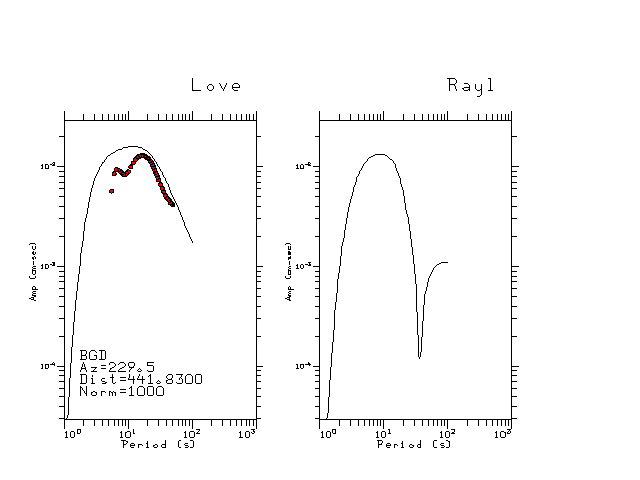 |
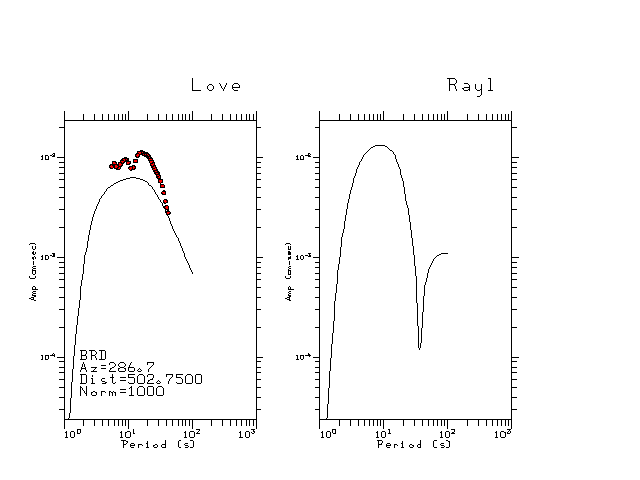 |
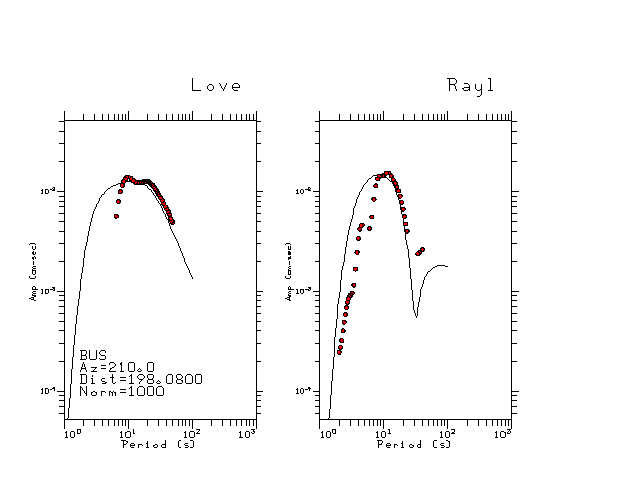 |
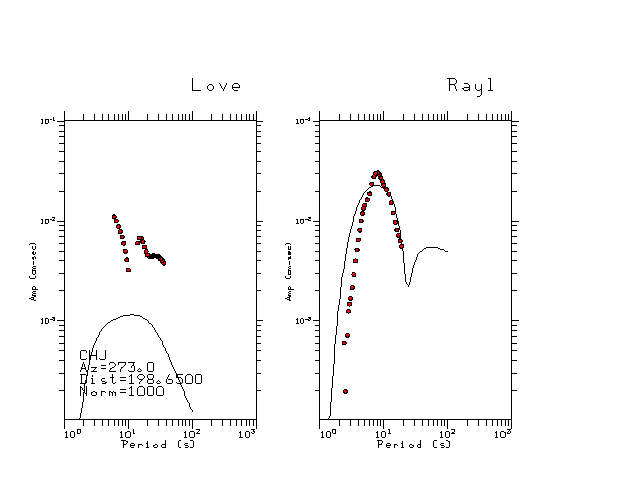 |
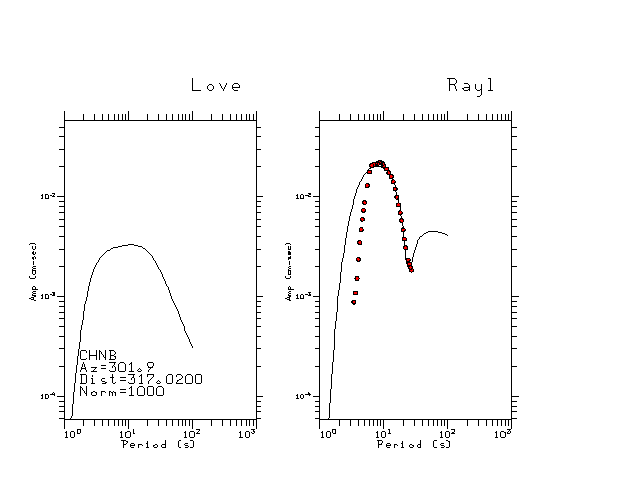 |
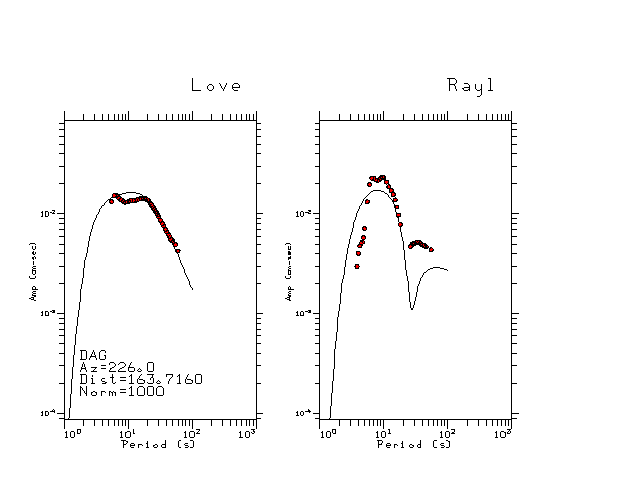 |
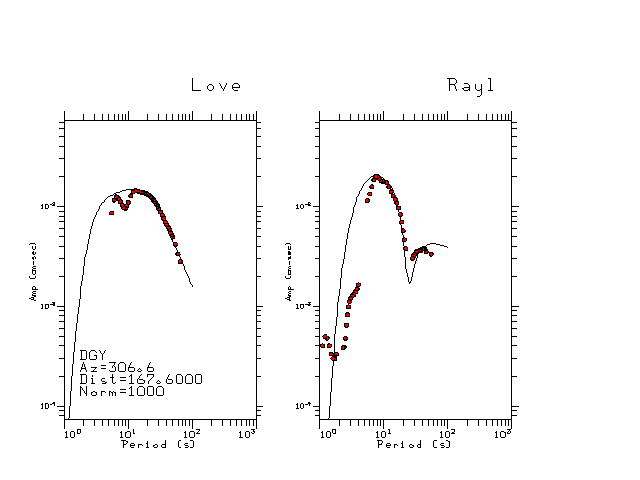 |
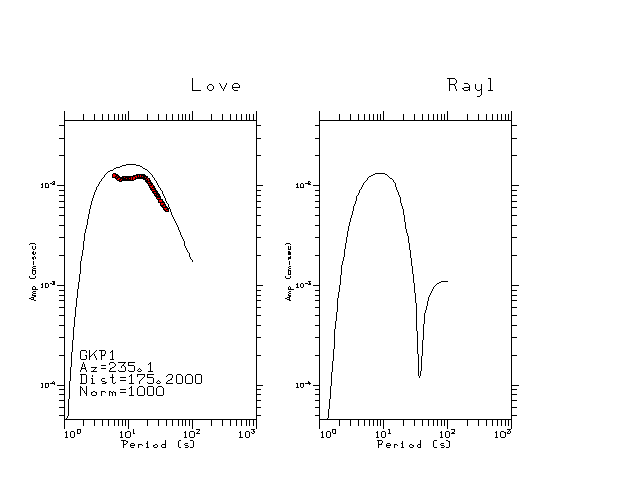 |
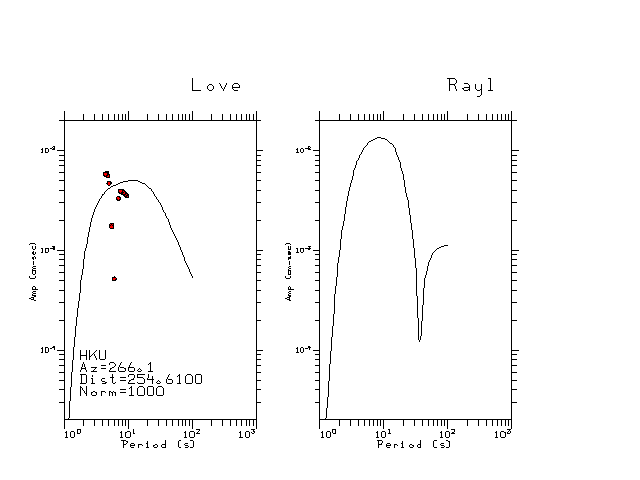 |
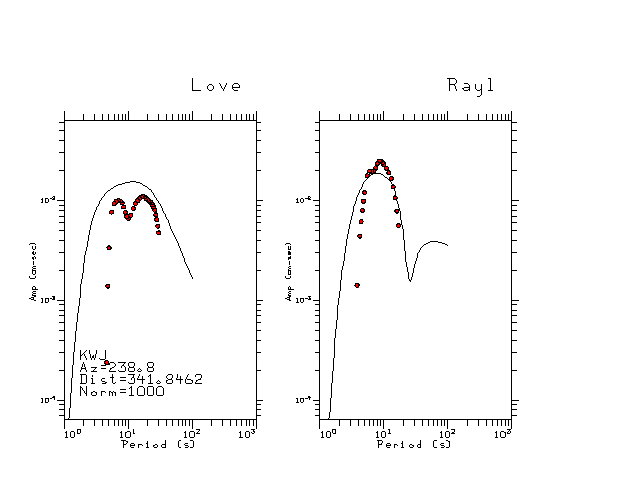 |
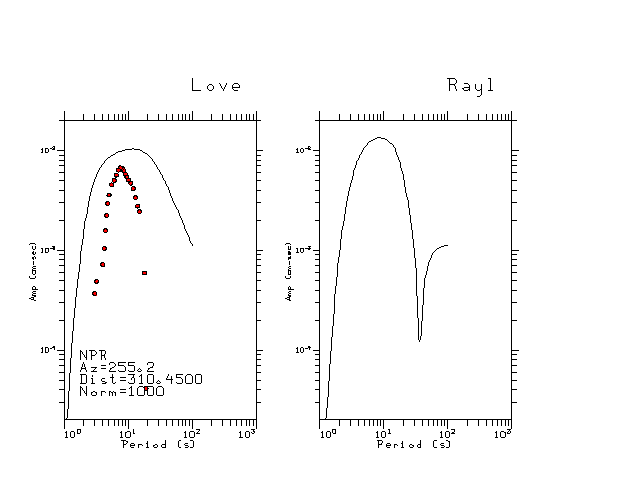 |
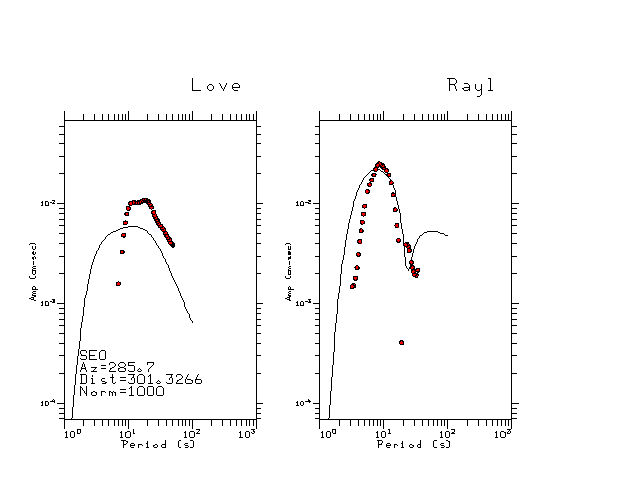 |
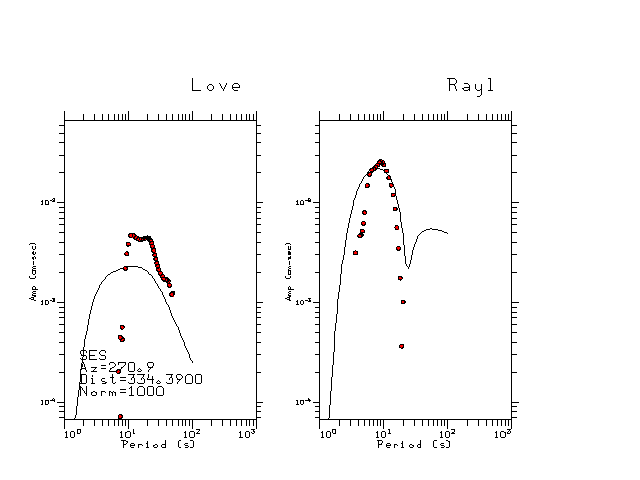 |
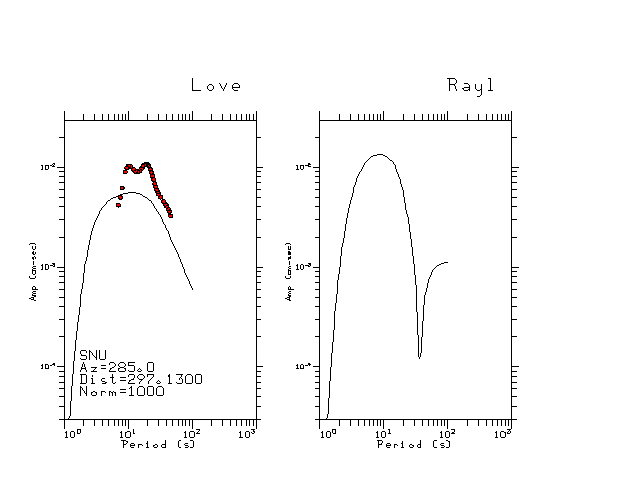 |
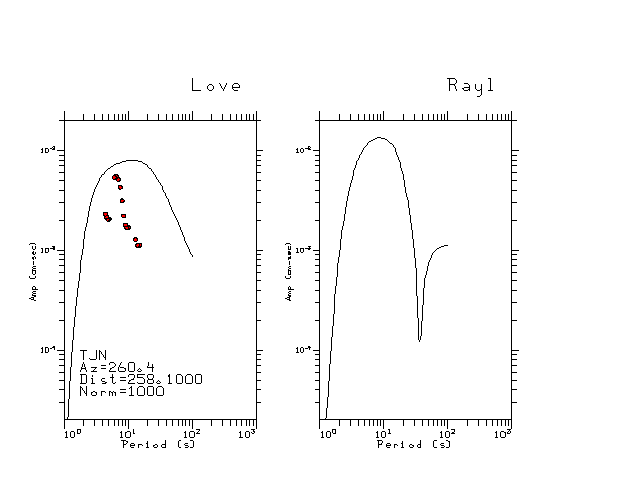 |
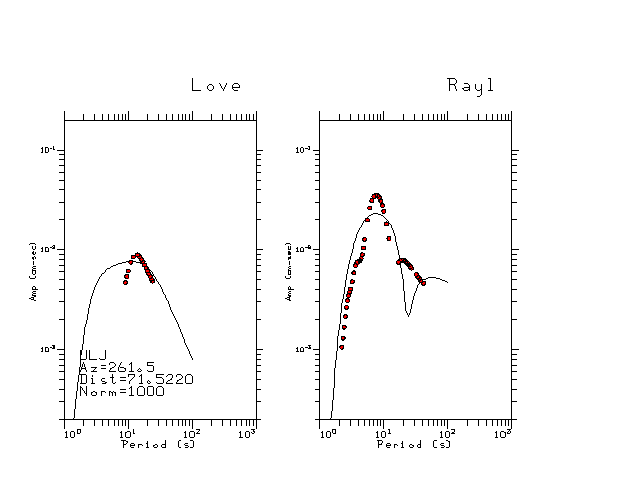 |
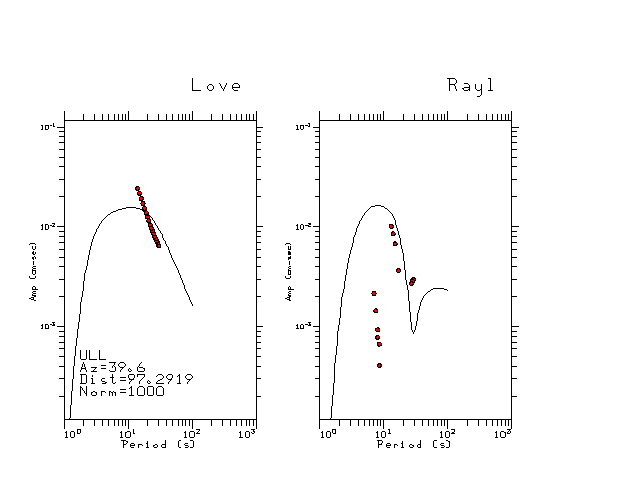 |
Here we tabulate the reasons for not using certain digital data sets